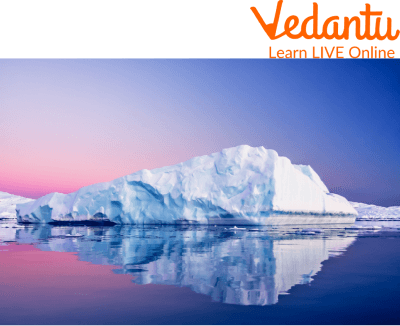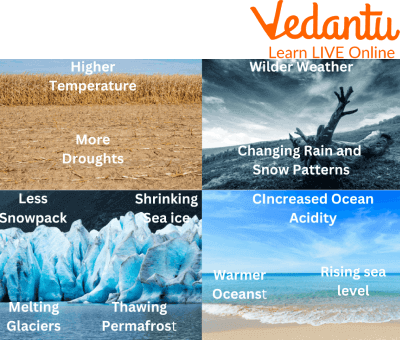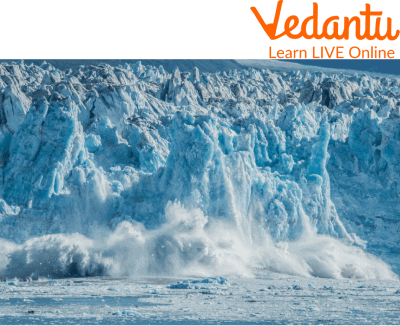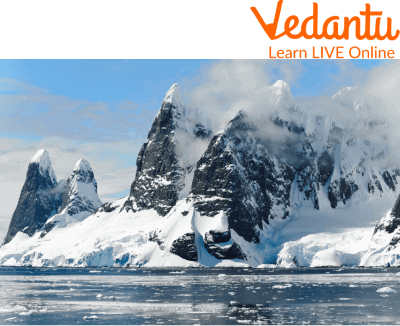




Why Understanding Glaciers Matters in Environmental Studies
Have you ever seen a few boulders of ice in the water? Have you ever imagined how these ice mountains were formed? Or ever wondered how big these are under the water? These big boulders of ice are called glaciers. These usually are seen in places where the temperature is below zero degree celsius or at places where there is always cold or extremely cold weather; these are the places where you will find these glaciers. In this article, we will look at various glacier information and also learn fun facts about glaciers. So let's start learning.

Glacier
Common Glacier Information
A glacier is a huge region of solid ice which is continuously frozen. Glaciers often move slowly across the landscape. Glaciers blanketed significant portions of the planet a few thousand years ago. Glaciers once blanketed approximately 30% of the Surface of the planet. Fewer glaciers existed in the past compared to the present.
Presently, glaciers may be found all over the planet. Greenland and Antarctica are both mostly topped by huge layers of glacier ice. Minor glaciers can be found in the European Alps, the Mountain Range of North America, and even in high regions close to the equator.
The glaciers are created when snow is compressed with high pressure until it turns into ice. These ice particles or glaciers build up over time at places where the temperature does not rise high enough to defrost the winter weather conditions entirely. Due to this build-up of snow particles at a particular place, the weight of the particles exerts a lot of pressure on the snow itself eventually turning the snow into what we call a glacier.
Facts About Glaciers Melting
The melting of glaciers can have a huge impact on our planet and also on our lives. Below listed are some fun facts about glacier melting that all of us should know.
The most astonishing fact about glaciers is that the glaciers over the entire globe are the storehouse of about 3/4th of all the freshwater that is present on the earth.
Presently, it is believed that if global warming continues to raise the temperature of the world this will eventually lead to the melting of glaciers. This in turn will raise the sea level and will lead to flooding of various cities of the world.
Presently, the sea level is rising about 2 millimetres annually and scientists believe that this is because of the melting of glaciers.

Impacts of Glacier Melting
Types of Glaciers
According to scientists, various types of glaciers have been found all over the world and a few of those main types are listed below.
Calving Glaciers - These are the glaciers that break off from the main huge glaciers and drift into some water bodies. These glaciers are also called tidewater glaciers because they can cause tide-like movements in waters.

Calving Glacier
Hanging Glaciers - These are the glaciers that hang off the mountain sides above the glacial valley but never can make it to the valley when the glacier slits these are known as hanging glaciers.
Ice Cap Glaciers - These types of glaciers are formed when there is no land left uncovered from the ice, not even the peaks of the high mountain.
Polar Glacier- This type of glacier is found in places where the temperature is always below the freezing point.

Polar Glacier
Interesting Facts About Glaciers
Greenland is mostly blanketed by a massive ice cap glacier that, in some places, is nearly two kilometres broad.
A glacier that is receding isn't currently moving backwards; rather, it is dissolving more quickly compared to making new ice.
The Lambert Glacier of Antarctica, which is around 100 km wide, 400 km long, and 2.5km deep, is indeed the biggest glacier on the planet.
Glacial movements are similar to river movements.
Summary
To conclude all the learnings from this article, we can say glaciers can be found anywhere on the earth where the temperature is below a certain range. They can be found anywhere instead of just the North Pole or South Pole. In this article, we learned that glacier melting can cause major problems to our climate from the increment in temperature to causing floods. Therefore, we need to keep a check on our activities that can be potentially harmful to our environment and the glaciers. With this, we would like to end this topic and hope that we were clear enough to be understood easily.
FAQs on Facts About Glaciers: Essential Concepts for Students
1. How are glaciers formed?
A glacier is formed over hundreds or thousands of years in places where more snow falls in winter than melts in summer. This leftover snow piles up in layers. The immense weight of the top layers compresses the snow underneath, turning it into a denser form called firn. As more pressure is applied, this firn gets squeezed into solid glacial ice, a huge mass of ice so heavy that it begins to move.
2. What makes glacial ice different from the ice in a freezer?
The main difference is density. The ice in your freezer forms quickly and traps many tiny air bubbles, which makes it look white or cloudy. Glacial ice, however, is formed under extreme pressure that squeezes most of the air bubbles out. This makes it much denser and gives it a unique, beautiful blue colour because it absorbs other colours of the light spectrum.
3. If glaciers are made of solid ice, how can they move?
Glaciers move like very slow rivers, and this movement is one of their defining features. They move in two main ways:
- Plastic Flow: The immense weight and pressure from the glacier's own mass cause the ice crystals to deform and slide past one another, allowing the glacier to slowly flow and change shape.
- Basal Sliding: Some glaciers slide on a thin layer of meltwater at their base, which acts as a lubricant between the ice and the ground.
4. What is the difference between a glacier and an iceberg?
The key difference is their location. A glacier is a large, moving river of ice that is found on land. An iceberg is a large chunk of ice that has broken off from a glacier (a process called calving) and is now floating in an ocean or a lake. So, all icebergs were once part of a glacier.
5. How big can glaciers be?
Glaciers vary greatly in size. The smallest, known as cirque glaciers, might be the size of a football field. The largest types are called ice sheets, which are enormous bodies of ice that cover entire continents. The Antarctic and Greenland ice sheets are the biggest examples, containing more than 99% of the world's glacial ice.
6. Why are glaciers important for our planet?
Glaciers are crucial for several reasons:
- They store about 70% of the Earth's freshwater.
- Their meltwater provides essential drinking and irrigation water for communities downstream.
- Their white surface reflects sunlight back into space, helping to regulate the Earth's temperature.
- They provide scientists with valuable information about past climate and atmospheric conditions.
7. Where are most of the world's glaciers found?
The vast majority of glaciers are found in the polar regions. The Antarctic Ice Sheet holds about 90% of all the ice on Earth. The Greenland Ice Sheet is the next largest. The remaining glaciers are located in high-altitude mountain ranges around the world, such as the Himalayas, the Andes, the Rockies, and the Alps.
8. Is it safe to drink water directly from a glacier?
While glacial meltwater is often called the freshest water on Earth, drinking it directly is not always recommended. The water can contain fine, silt-like rock particles known as glacial flour, which can be harsh on the digestive system. It is always safer to filter water from any natural source before drinking it.









